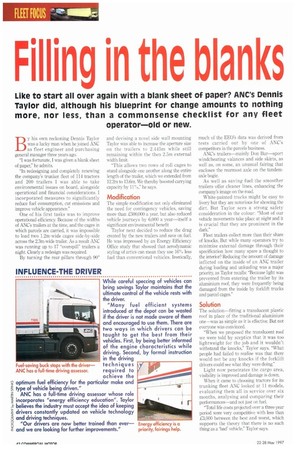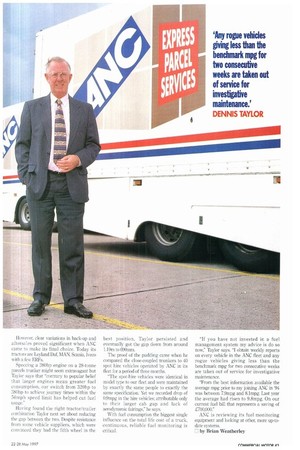Filling in the blanks
Page 44

Page 45

If you've noticed an error in this article please click here to report it so we can fix it.
Like to start all over again with a blank sheet of paper? ANC's Dennis Taylor did, although his blueprint for change amounts to nothing more, nor less, than a commonsense checklist for any fleet operator old or new.
By his own reckoning Dennis Taylor was a lucky man when he joined ANC as fleet engineer and purchasing general manager three years ago.
"I was fortunate, I was given a blank sheet of paper," he admits.
"In redesigning and completely renewing the company's trunker fleet of 114 tractors and 200 trailers I was able to take environmental issues on board, alongside operational and financial considerations. I incorporated measures to significantly reduce fuel consumption, cut emissions and improve vehicle appearance."
One of his first tasks was to improve operational efficiency. Because of the widths of ANC's trailers at the time, and the cages in which parcels are carried, it was impossible to load two 1.2m-wide cages side-by-side across the 2.3m-wide trailer. As a result ANC was running up to 17 "overspill" trailers a night. Clearly a redesign was required.
By turning the rear pillars through 90°
and devising a novel side wall mounting Taylor was able to increase the aperture size on the trailers to 2.445m while still remaining within the then 2.5m external width limit.
This allows two rows of roll cages to stand alongside one another along the entire length of the trailer, which we extended from 12.2m to 13.6m. We thereby boosted carrying capacity by 11'. (i," he says.
Modification
The simple modification not only eliminated the need for contingency vehicles, saving more than £500,000 a year, but also reduced vehicle journeys by 6,000 a year—itself a significant environmental benefit Taylor next decided to reduce the drag created by the new trailers and save on fuel. He was impressed by an Energy Efficiency Office study that showed that aerodynamic styling of artics can mean they use 16% less fuel than conventional vehicles. Ironically, much of the EEO's data was derived from tests carried out by one of ANC's competitors in the parcels business.
ANC's trailers—mainly Don Bur—sport windcheating valances and side skirts, as well as, on some, an unusual fairing that encloses the rearmost axle on the tandemaxle bogie.
As well as saving fuel the smoother trailers offer cleaner lines, enhancing the company's image on the road.
White-painted trucks might be easy to livery but they are notorious for showing the dirt. But Taylor sees a strong safety consideration in the colour: "Most of our vehicle movements take place at night and it is crucial that they are prominent in the dark."
Fleet trailers collect more than their share of knocks. But while many operators try to minimise external damage through their specification how many spare a thought to the interior? Reducing the amount of damage inflicted on the inside of an ANC trailer during loading and unloading was a major priority, as Taylor recalls: "Because light was prevented from entering the trailer by its aluminium roof, they were frequently being damaged from the inside by forklift trucks and parcel cages."
Solution
The solution—fitting a translucent plastic roof in place of the traditional aluminium one—was as simple as it is effective. But not everyone was convinced.
"When we proposed the translucent roof we were told by sceptics that it was too lightweight for the job and it wouldn't withstand the knocks," Taylor says. "What people had failed to realise was that there would not be any knocks if the forklift drivers could see what they were doing."
Light now penetrates the cargo area, visibility is improved and damage is down.
When it came to choosing tractors for its trunking fleet ANC looked at 11 models, evaluating them all in service over six months, analysing and comparing their performances—and not just on fuel.
"Total life costs projected over a three-year period were very competitive with less than £3,000 between the best and worst, which supports the theory that there is no such thing as a 'bad' vehicle," Taylor says. However, clear variations in back-up and aftersales proved significant when ANC came to make its final choice. Today its tractors are Leyland Daf, MAN, Scania, Iveco with a few ERFs.
Speccing a 380hp engine on a 28-tonne parcels trunker might seem extravagant but Taylor says that "contrary to popular belief that larger engines mean greater fuel consumption, our switch from 320hp to 380hp to achieve journey times within the 5fimph speed limit has helped cut fuel usage."
Having found the right tractor/trailer combination Taylor next set about reducing the gap between the two. Despite resistance from some vehicle suppliers, which were convinced they had the fifth wheel in the best position, Taylor persisted and eventually got the gap down from around 1.19m to 690mm.
The proof of the pudding came when he compared the close-coupled trunkers to 40 spot hire vehicles operated by ANC in its fleet for a period of three months.
"The spot-hire vehicles were identical in model type to our fleet and were maintained by exactly the same people to exactly the same specification. Yet we recorded drop of 0.9mpg in the hire vehicles: attributable only to their larger cab gap and lack of aerodynamic fairings," he says.
With fuel consumption the biggest single influence on the total life cost of a truck, continuous, reliable fuel monitoring is "If you have not invested in a fuel management system my advice is do so now," Taylor says. "I obtain weekly reports on every vehicle in the ANC fleet and any rogue vehicles giving less than the benchmark mpg for two consecutive weeks are taken out of service for investigative maintenance.
"From the best information available the average mpg prior to my joining ANC in '94 was between 7.9mpg and 8.1mpg. Last year the average had risen to 9.8mpg. On our current fuel bill that represents a saving of 1700.000."
ANC is reviewing its fuel monitoring equipment and looking at other, more up-todate systems.
0 by Brian Weatherley
















































































































